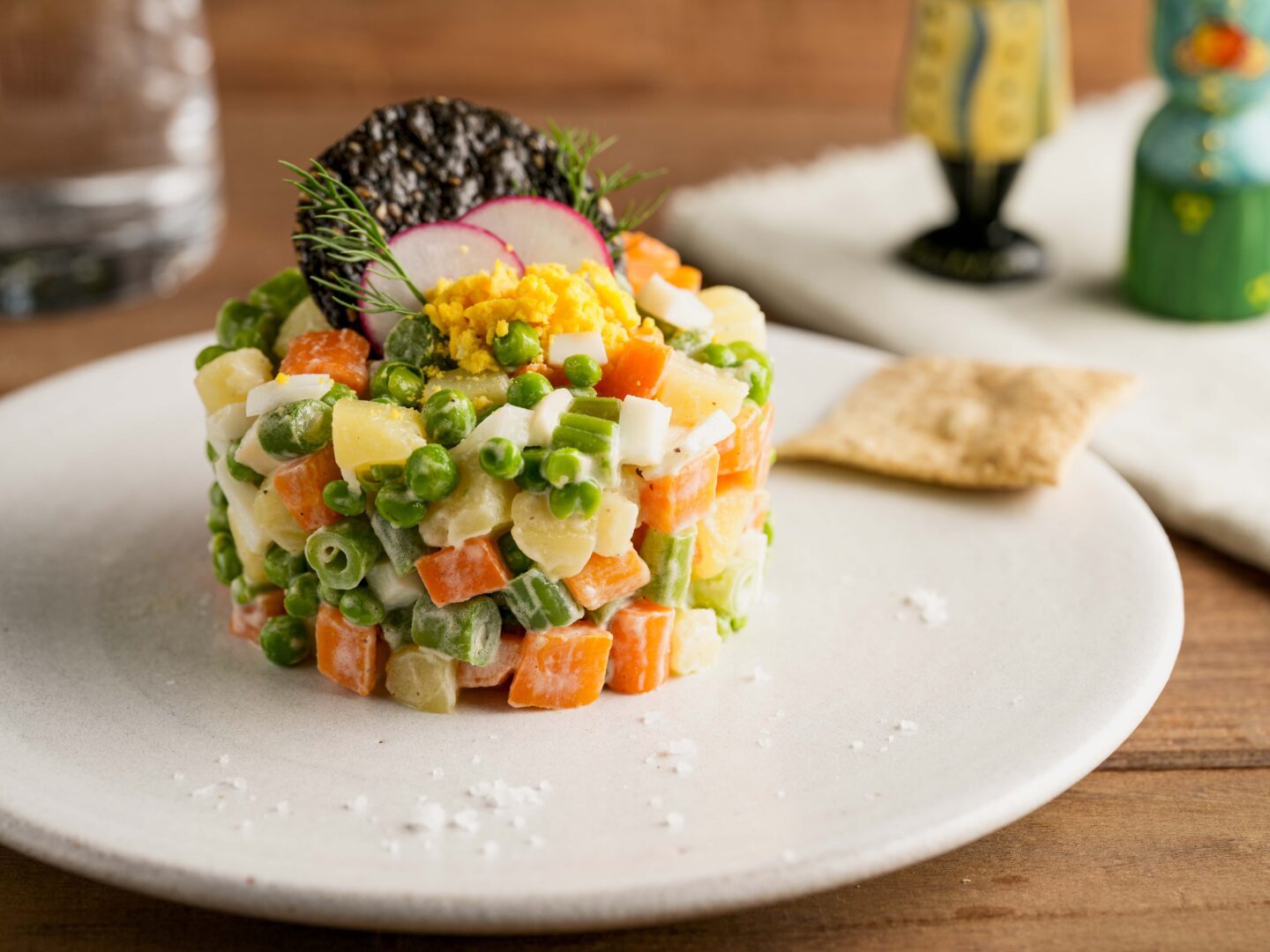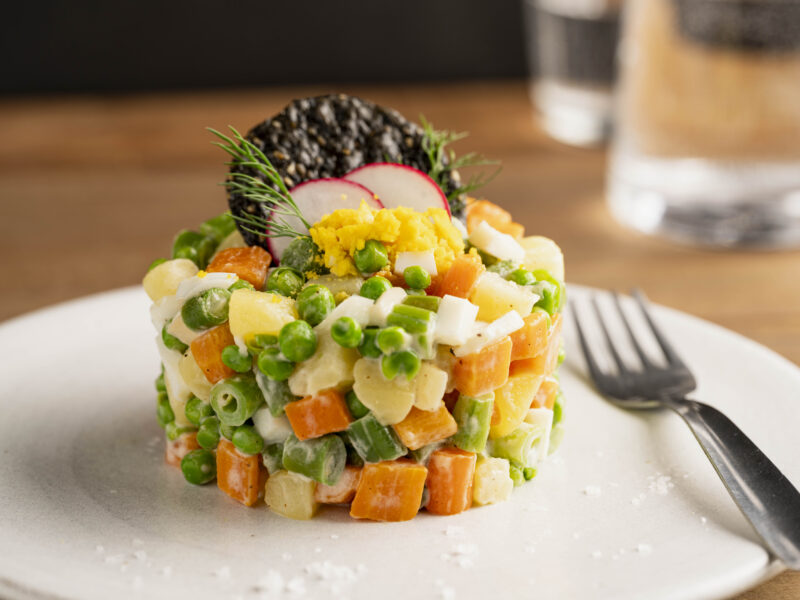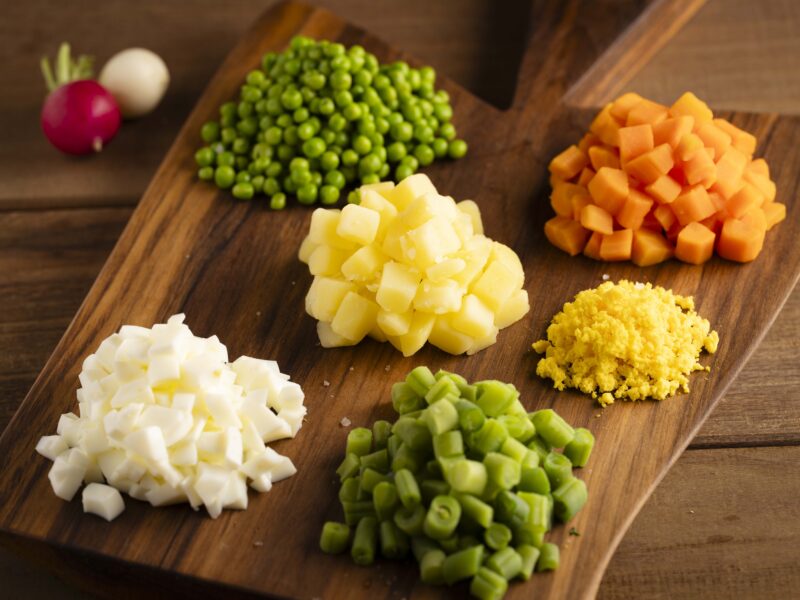Russian salad - classic recipe with modern twists
It was during a sun-drenched lunch in a sleepy Spanish village that I was suddenly transported back to my childhood. There it was again: a bowl of creamy, colourful Russian salad – familiar, yet entirely new. What began as a luxurious creation by a French – Belgian chef in 19th-century Moscow has since travelled the world, transforming along the way. From tapas bars in Spain to festive tables in Italy and South America, this humble salad has taken on countless forms – each one a reflection of local taste and tradition.

A salad with a story
The story of Russian salad begins in the 1860s, in the heart of imperial Moscow. At the renowned restaurant L’Hermitage, French – Belgian chef Lucien Olivier crafted a lavish dish that quickly captivated the city’s elite. His creation featured crayfish, caviar, capers, duck breast, and a mysterious, velvety dressing – a recipe he guarded closely. The salad became so iconic it took on his name: Salad Olivier.
After Olivier’s death, the original recipe faded into legend. What remained was its spirit – reinvented in simpler forms with potatoes, vegetables, and mayonnaise. As the dish travelled across borders, each region adapted it to local tastes.
From Moscow to Buenos Aires: one salad, a thousand faces
What we know today as Russian salad is a true culinary chameleon. In Russia, it still proudly bears the name Salad Olivier and is typically served with meat, chicken, or sausage. In Spain, it’s a staple on every tapas menu, often paired with tuna and roasted red peppers. In France, it appears in the legendary Larousse Gastronomique, elevated with lobster and truffle. In Mexico, a fiery chilli is essential. And in Buenos Aires? There, it’s stripped down to its purest form: just potato, carrot, and green beans – all bound together with creamy mayonnaise.
Even its name shifts as it crosses borders:
Romania: Salată de boeuf – always with meat
Germany: Italienischer Salat
France: Macédoine de légumes
North America: Olivier salad
What's in a classic Russian salad?
At its heart, Russian salad is beautifully simple: potatoes, carrots, green beans, peas, boiled egg, and – of course – a creamy, tangy mayonnaise.
But the beauty lies in its flexibility. Feel free to make it your own:
- Meat: ham, chicken, beef, or sausage
- Fish: tuna, crab, prawns, or anchovies
- Vegetables: cauliflower, broccoli, celery, beetroot, artichoke, or green asparagus
- And for the finishing touch? Think pickles, capers, olives, or a handful of fresh herbs to brighten it all up.

Tips for a successful Russian salad
A good Russian salad may be simple, but it rewards a little extra care:
- Make your mayonnaise from scratch – it truly makes all the difference.
- Don’t hold back on flavour – a good mayo needs mustard and vinegar for that essential kick.
- Use firm-boiling potatoes – they hold their shape and keep the salad neat.
- Cook each vegetable separately – every ingredient has its own perfect cooking time.
- Let everything cool completely before mixing – this keeps the texture fresh and firm.
- Go easy on the mayo – the vegetables are the stars of the show.

A seasonal dish with charm
Despite its bright, spring-like colours, Russian salad is very much a dish for the colder months. In many Italian and South American households, it’s a cherished part of the Christmas table. Serve it as a festive starter with crusty bread, as a vibrant side to a winter meal, or simply as a comforting lunch on a chilly day.
Recipe: Russian salad
This version is simple and versatile – the perfect base to make your own. Add what you love, skip what you don’t. That’s the beauty of this timeless dish.
Ingredients:
For the salad:
- 250 g carrots
- 300 g firm potatoes
- 150 g green beans
- 150 g peas
- 2 eggs
For the mayonnaise:
- 2 egg yolks
- 1 tbsp Dijon mustard
- 3 tbsp cider vinegar
- 250 ml neutral vegetable oil
- Pepper and salt
For the finishing touch:
- Radishes
- Gherkins
- A few sprigs of dill, parsley and young lettuce
- Bread, olive oil
-
Step 1: Prepare vegetables
Peel the potatoes and carrots. Cut them, along with the beans, into small, evenly sized cubes. This gives the salad a refined, consistent texture.
![Russian Salad 12]()
-
Step 2: Boil the vegetables and eggs
Boil or steam each vegetable separately until just tender:
- Potatoes: 10 minutes
- Carrots: 6 – 7 minutes
- Beans: 5 – 6 minutes
- Peas: 2 – 3 minutes
Drain well and allow to cool completely.
Boil the eggs for 8 – 9 minutes until hard. Cool them under cold water, peel, and cut into wedges.
-
Step 3: Make the mayonnaise
Whisk the egg yolks with mustard and vinegar. Slowly add the oil, drop by drop, while whisking continuously until you have a thick, creamy mayonnaise. Season with salt and pepper. For extra zing, add a touch more mustard or vinegar.
-
Step 4: Mix the salad
Gently fold the mayonnaise into the cooled vegetables. Start with a small amount and add more to taste – the salad should be creamy but not overloaded.
-
Step 5: Serve and finish
Spoon the salad into a serving bowl, a pretty glass, or shape it with a ring for an elegant presentation. Garnish with egg wedges, radish slices, gherkin, fresh herbs or a few lettuce leaves.
Toast thin slices of bread brushed with olive oil until golden. Serve alongside.
![Russian Salad 3]()

